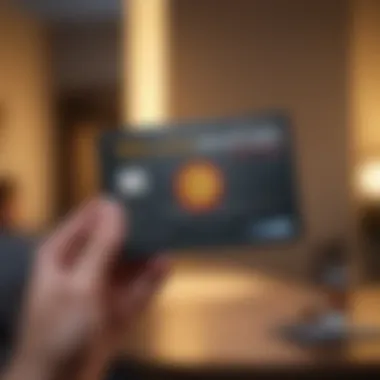A Detailed Guide to Wells Fargo Student Credit Card


Intro
Navigating the world of credit cards, especially for students, can feel like trying to find your way through a maze blindfolded. With the right information, however, you can tackle the complexities of applying for a Wells Fargo student credit card efficiently and smartly. Many young adults are stepping into their first financial responsibilities, and understanding how to approach credit is crucial. This guide aims to break down everything you need to know about the application process, eligibility requirements, and the benefits and drawbacks of choosing this particular card.
Understanding Financial Concepts
Before diving into the specifics of the Wells Fargo student credit card application, it’s essential to grasp some foundational financial concepts that will empower you throughout this journey.
Definitions of Key Terms
Having a strong grasp of financial terminology can make a significant difference in your decision-making process. Here are a few terms to familiarize yourself with:
- Credit Score: A number that represents your creditworthiness, calculated based on your credit history.
- APR (Annual Percentage Rate): The cost of borrowing money on a yearly basis, expressed as a percentage.
- Rewards Programs: Incentives offered by credit card companies for using their cards, often in the form of cash back or points.
Importance of Financial Literacy
Understanding these terms isn’t just academic; it’s about gaining the confidence to manage your finances effectively. Financial literacy can prevent you from falling into common traps, such as accumulating credit card debt without a plan for repayment. It equips you with the skills needed to make informed decisions—whether choosing the right card or managing your budget.
"Knowledge is power when it comes to financial decisions!"
Creating a Personal Budget
Budgeting is a fundamental skill that goes hand-in-hand with responsible credit usage. A well-structured budget helps you allocate funds wisely, ensuring you can pay off what you owe while still saving for future goals.
Setting Financial Goals
Begin with identifying what you want to achieve financially. Are you hoping to save for a car, travel, or build a credit history? By setting clear financial goals, you create a roadmap that can help guide your spending and saving.
Tracking Income and Expenses
Keeping an eye on your income and expenses is essential for maintaining a balanced budget. Here’s how you can do it:
- Document all Income Sources: Include your earnings from work, scholarships, or any side gigs you may have.
- List Out Monthly Expenses: Don’t forget essentials like rent, utilities, groceries, and any entertainment.
- Utilize Budget Apps: Consider tools like Mint or You Need a Budget to help track your spending.
Managing your budget also ties into your credit utilization ratio. This ratio compares your credit card balances to your credit limits. A lower ratio is generally better for your credit score and helps maintain a good balance in your financial life.
With these foundational elements in place, you'll be well-prepared to tackle the specifics of applying for a Wells Fargo student credit card. Understanding what you need and how to manage your finances ensures that when you make the leap into credit, you do so informed and ready.
Prologue to Wells Fargo Student Credit Card
When it comes to students stepping into the world of finance, the Wells Fargo Student Credit Card stands as a significant option worth considering. In an era where managing finances is increasingly pivotal, understanding the intricacies of these cards can empower students not only to build a credit history but also to navigate their expenses more effectively. This introduction aims to shed light on why the Wells Fargo Student Credit Card is an important tool for college-goers and young professionals alike.
Understanding Student Credit Cards
Student credit cards are specifically designed for individuals who are new to the world of credit. They're tailored to address the unique needs of students, who may not possess a lengthy credit history. One primary feature of these cards is their typically lower credit limits. This serves as a safety net, helping students to avoid falling too deep into debt. Moreover, many student cards come with perks like no annual fees, rewards on purchases, and the chance to build credit responsibly. It's almost like getting your feet wet before diving in completely.
Additionally, using a student credit card can be an invaluable learning opportunity. It allows individuals to make purchases—like books and supplies—and in turn, encourages timely payments, which is crucial for establishing a good credit score. With the Wells Fargo Student Credit Card, students can not only make transactions but also take part in rewards programs. This adds an extra layer of incentive to engage with their financial habits positively.
Importance of Credit for Students
For students, credit can be much more than just a means to finance purchases; it can be a significant stepping stone towards future financial endeavors. Having a good credit score opens doors to better interest rates for loans, approvals for rentals, and even job opportunities in some industries. Thus, getting acquainted with credit early on can be a strategic advantage.
Possessing a credit card, particularly one designed for students, helps in developing a solid credit history. With responsible usage—keeping balances low and making payments on time—students can cultivate a strong credit profile. This can have lasting benefits, as it shows future lenders that they are trustworthy and capable. By engaging with the Wells Fargo Student Credit Card, students are not just spending money—they're investing in their financial futures.
"Managing credit is like planting a seed. With care and attention, it can blossom into something beautiful—financial freedom."
With various options available, understanding the Wells Fargo Student Credit Card and its advantages can set the foundation for smarter financial decisions. So, as we delve deeper into this guide, consider how this card can serve as a launchpad into a financially stable future.


Eligibility Criteria for Applying
Before embarking on the journey of applying for a Wells Fargo student credit card, it’s vital to understand the eligibility criteria. These requirements serve as checkpoints, ensuring that applicants meet certain standards. This segment demystifies the key elements involved, helping you to assess your readiness. Not all credit cards are created the same, and knowing what’s needed can prevent unnecessary dismay later on.
Age and Residency Requirements
To apply for a Wells Fargo student credit card, you generally need to be at least 18 years old. This age requirement aligns with many credit institutions, given that 18 is typically the age of legal adulthood in the U.S. However, if you are younger than 21, the process may require a bit more scrutiny. This extra layer exists to ensure that younger applicants have a way to prove they can manage their credit responsibly.
Moreover, you also need to be a U.S. resident or a non-resident with a valid form of identification potentially. Wells Fargo aims to ensure that applicants can be reached and verified. If you're just visiting or studying temporarily, this might put the brakes on your application.
Educational Status
Being a student is a core aspect of qualifying for this card. Typically, you’re expected to be currently enrolled in a degree program, whether that's an associate’s degree, bachelor's degree, or higher. This requirement showcases Wells Fargo’s commitment to supporting the financial endeavors of students. Your school enrollment may need to be confirmed, so keep your student ID or enrollment letters handy. As a student, you may hold a lower credit score or even no credit history at all. Wells Fargo's card is designed with this in mind, serving as a stepping stone to your credit journey.
Income and Credit History Considerations
Income is another crucial factor. There's no golden rule here, but generally, having some form of income—be it from a part-time job, internships, or allowances—can significantly boost your chances of approval. It signals to the bank that you have a reliable source to repay any debt you may accumulate. But don’t fret if you’re a full-time student relying heavily on student loans; some cards cater to students with limited income as well.
Equally important is your credit history. If you’re a fresh face in the credit world, don’t let lacking history deter you. Wells Fargo considers various aspects of your financial standing. If you do have a credit report, it’s advisable to review it for any glaring issues. Address any discrepancies so that your application reflects your actual creditworthiness.
"Being informed about eligibility criteria streamlines your path to managing credit effectively."
Understanding the eligibility requirements for the Wells Fargo student credit card equips you with the knowledge to proceed with confidence. By addressing your age, educational association, income, and credit history, you can tackle the application process with clarity. Ensure you check off each element so that you maximize your chances of approval.
The Application Process
Understanding how to apply for a Wells Fargo student credit card is a pivotal step for anyone looking to build credit while managing their finances effectively. This process encompasses numerous components that can seem daunting at first. However, knowing what to expect can smoothen the experience significantly and set the stage for responsible credit management.
Gathering Necessary Documentation
Before diving into the online application, it’s essential to gather all the necessary documents. Having these documents ready not only speeds up the application process but also increases the chances of approval. Here’s what you typically need:
- Identification Proof: Valid photo ID like a driver's license or a passport.
- Social Security Number: This helps in verifying your identity and credit history.
- Proof of Enrollment: A current student ID or acceptance letter from your educational institution.
- Income Information: Though many students may not have substantial income, documenting any source of income—part-time job payslips or even allowances—can be beneficial.
With everything in hand, you’ll be able to fill out the application promptly without scrambling for documents.
Online Application Steps
Once you've prepared your documentation, you’re ready to start your online application. Wells Fargo has made the process quite user-friendly, enabling applicants to navigate easily. Here’s a step-by-step outline:
- Visit the Wells Fargo Website: Navigate to the student credit card section.
- Select the Student Card Option: There may be various credit products available. Ensure you choose the student card.
- Fill Out Your Personal Information: Enter your name, address, date of birth, and Social Security number.
- Provide Financial Information: This includes your income, employment status (if applicable), and educational status.
- Review Your Application: Take a moment to double-check that all your information is accurate.
- Submit: After ensuring every detail is correct, hit that submit button.
This online system is typically swift and provides immediate acknowledgment once submitted.
What to Expect During Approval
Once your application is submitted, it usually does not take long to receive an approval decision. Wells Fargo often communicates this through email or a phone call. Here’s what you might experience during the approval phase:
- Review Time: While many applications get approved within minutes, some might require further review, particularly if any red flags are encountered regarding your credit history.
- Potential Follow-Up: If your information prompts further questions, expect a follow-up call or email. They might request additional documentation.
- Notification of Decision: You will be informed whether you’ve been approved, denied, or required to add further details. If approved, you can typically expect your credit card to arrive in the mail within a week or so.
Tip: If you don’t receive a decision right away, don’t panic. Sometimes, thorough assessments take additional time, especially for students who may not have a lengthy credit history.
Understanding Credit Scores
When it comes to student credit cards, credit scores play a vital role in how you manage your finances. They’re like your financial report card, giving insights into how banks and lenders assess your reliability when borrowing money. Understanding credit scores not only demystifies the process but empowers you to make informed decisions as you navigate the new world of credit.
Definition and Importance of Credit Scores


A credit score is a three-digit number, typically ranging from 300 to 850, that summarizes your creditworthiness. Lenders use this score to evaluate the risk of lending you money. Higher scores generally indicate better credit history, which can lead to lower interest rates on loans and more favorable terms overall.
Some essential components that contribute to your credit score include:
- Payment History (35%): Timely payments can significantly impact your score.
- Credit Utilization (30%): This ratio compares your revolving credit accounts to their limits. Keeping it below 30% can help boost your score.
- Length of Credit History (15%): A longer history is beneficial, but students often start with little to none, so it’s crucial to build this over time.
- Types of Credit (10%): Having a mix of credit types, such as revolving and installment loans, can positively affect your score.
- New Credit Accounts (10%): Too many credit inquiries in a short period may indicate risk and affect your score negatively.
Understanding this definition highlights that every aspect of your credit behaviors matters. Getting it right from the start can set you on a successful financial path.
Impact of Student Credit Cards on Credit Scores
Obtaining a Wells Fargo student credit card can serve as your first stepping stone toward building a solid credit score. Here’s how student credit cards can affect your credit profile:
- Establishing Credit History: Having any credit card enables you to start building a history, which is crucial for your credit score. Even though you might be starting fresh, timely payments can work wonders.
- Improving Credit Mix: If you only have student loans, adding a credit card diversifies your credit profile, which can be a boon for your score.
- Responsible Spending: With a credit line, you learn to manage spending and repayments. As you practice keeping your balance low relative to your limit, it can help maintain a good credit utilization ratio.
- Monitoring Your Progress: Using tools to regularly check your credit score can provide insight into how your card usage is impacting your score. Many banks offer free score tracking for their credit cardholders.
Remember, though, that while student credit cards can help build a healthy credit score, they come with responsibilities. Failing to make payments can lead to fees and damage your credit rating. Always keep an eye on where your finances stand and take steps to improve when necessary.
"Understanding how credit scores function is your first line of defense against debt pitfalls and financial mismanagement."
Establishing a clear understanding of credit scores gives students and young professionals the tools they need to navigate credit responsibly, turning potential pitfalls into stepping stones for future financial success.
Benefits of Wells Fargo Student Credit Card
When it comes to navigating the financial waters of student life, the Wells Fargo Student Credit Card offers a number of distinct advantages. These benefits can play a vital role in helping students not just manage their expenses, but also build a foundation for their financial future. Understanding these benefits is paramount for students and young professionals who might be considering such a card. Below, we’ll delve into the core advantages, focusing on rewards programs, building credit history, and flexible payment options.
Rewards Programs
One of the shining features of the Wells Fargo Student Credit Card is its rewards programs. These perks are crucial for students who are often on tight budgets. You'll earn points for every dollar spent, which can accumulate faster than you might think. These points can be redeemed for things like gift cards or even travel expenses. This adds a layer of incentive to everyday purchases.
Here’s a closer look at how the rewards can benefit students:
- Everyday Purchases: Whether it's textbooks, coffee, or dining out, every dollar spent translates into rewards.
- Cashback Options: It’s not just about points; some rewards allow for a percentage back that can ultimately ease the financial burden.
- Promotional Offers: Another attractive aspect is irregular promotions which might enhance point earnings during specific periods.
Such advantages encourage responsible spending and demonstrate how quickly these rewards can stack up, making it a win-win situation for savvy students.
Building Credit History
Credit history plays a vital role in financial stability. The Wells Fargo Student Credit Card is an excellent tool for students to begin building their credit from a young age. It provides a unique chance to establish a credit history without being chained to more risky financial practices.
- First Steps into Credit: For many young adults, this card serves as the first step into the world of credit. It helps them grasp the ins and outs of credit management.
- Record of Payments: Consistent and timely payments signal responsible financial behavior, which can positively impact credit scores down the line.
- Long-Term Benefits: A solid credit history opens doors for future borrowing, such as auto loans and mortgages. Starting early can yield benefits years later.
Building a healthy credit history can be a long game, but with the right strategy and discipline, the students can set themselves up for success.
Flexible Payment Options
Another appealing aspect of the Wells Fargo Student Credit Card is the flexibility it offers in payment options. This is especially vital for students who might face irregular income streams, such as part-time jobs or internships.
- Minimum Payment Choices: Students can choose from a range of minimum payments that suit their financial situations without straining their budgets.
- Payment Plans: The card often allows for scheduled payments, giving students the ability to plan effectively without the fear of overspending.
- Grace Periods: Understanding when interest kicks in helps students manage their cash flow without constantly worrying about accruing debt.
In essence, these flexible payment options not only promote responsible usage but also mitigate the risk of falling into a cycle of debt. They allow students to manage their finances more effectively, creating a balance between spending and saving.
"Being smart with money while in school is key. The Wells Fargo Student Credit Card provides a pathway to not just spend wisely but benefit from it too."
Common Pitfalls and Considerations
Navigating the realm of credit can be tough, especially for students eager to get their first credit card. The excitement is palpable, but it’s crucial to tread carefully. This section sheds light on common pitfalls and considerations when applying for the Wells Fargo student credit card. Identifying these areas can help you sidestep potential issues and equip you to sink your teeth into this new financial avenue with more confidence.
Understanding Interest Rates and Fees


When it comes to credit, understanding interest rates and fees is like knowing the lay of the land before you set out on a journey. Many students overlook this vital aspect, thinking it’s all smooth sailing after the approval. Yet, the reality can be quite different.
Wells Fargo, like many other banks, has interest rates that may vary based on your creditworthiness. Typically, students might see higher rates due to their limited credit history. It's a double-edged sword; while the card can help build a credit profile, if you carry a balance, those interest charges can quickly stack up like dishes waiting to be washed.
Some common fees associated with credit cards include:
- Annual Fees: Not all student credit cards charge these, but it’s essential to check.
- Late Payment Fees: Missing a due date can lead to penalties.
- Over-the-Limit Fees: This isn’t as common anymore, but it’s still something to keep an eye on.
Make sure to read the fine print, and keep in mind that while promotional offers can be enticing, they sometimes hide higher long-term rates. Always weigh the pros and cons before signing.
Potential for Debt Accumulation
This is a topic that warrants serious attention. One major risk of having access to credit is the potential for debt accumulation. Having a credit card can feel liberating, allowing purchases that weren’t possible before. But without a solid plan in place, those seemingly small purchases can lead to an ever-growing mountain of debt.
For instance, consider this scenario: you buy textbooks and a few campus essentials, thinking you’ll pay it off with your next paycheck. But life happens—the car breaks down, or that part-time job takes all day to pay. If you're not careful, the balance starts to swirl, and soon you're only making minimum payments. With interest piling on each month, that original debt can morph into something much larger.
To prevent this pitfall, consider the following strategies:
- Set a Budget: Establish a clear budget that includes your expected credit card expenses.
- Pay More Than the Minimum: If you can, pay more than what’s required each month to reduce your principal balance faster.
- Use Alerts and Notifications: Most banks provide options for alerts. Set reminders a few days before due dates to avoid surprises.
Ultimately, financial discipline is key. It helps to remember that credit is a tool; how you wield it makes all the difference.
"Credit is a double-edged sword; it offers freedom but demands responsibility."
Managing a Wells Fargo student credit card properly means being aware of these common pitfalls and keeping a close watch on your financial habits. By being proactive and informed, you’ll minimize risks and enhance the benefits that come with responsible credit management.
Managing Credit Responsibly
Managing credit responsibly is a crucial aspect of financial health, especially for students venturing into the world of credit with a Wells Fargo student credit card. This approach not only fosters good financial habits but also sets the stage for building a solid credit history. When students learn to handle credit with care, they acquire the tools necessary for achieving their future financial goals. This section will delve into vital elements that can help you navigate the landscape of credit without stumbling into common traps.
Tips for Staying Within Budget
Budgeting is the backbone of responsible credit management. It’s essential to draw up a clear budget that you stick to, which significantly aids in ensuring you don’t overspend. Here are some practical tips to consider:
- Track Your Spending: Keep an eye on where your money goes each month. This includes fixed expenses like tuition and rent, as well as discretionary spending like dining out and entertainment. Tools like budgeting apps can simplify this task.
- Set a Realistic Credit Limit: It’s easy to be tempted by that shiny new credit limit. However, setting a personal cap on how much you can charge each month can prevent you from getting in over your head.
- Prioritize Essentials Over Luxuries: Focus on needs first. If your budget only allows for a few non-essential purchases, make them count. This way, your spending can remain in check without compromising the possibility of enjoying your credit card benefits.
"A penny saved is a penny earned."
- Plan for Monthly Payments: Use a calendar to record when your credit card payments are due. Knowing what to expect each month can help you allocate funds appropriately and avoid late fees.
By following these tips for staying within budget, you'll harness the thrill of using your credit card without the anxiety of impending debt.
Monitoring Your Credit Activity
To successfully manage your credit, you must stay informed about your credit activity. Regular monitoring supports you in understanding how your credit usage impacts your credit score and can prevent potential errors. Here’s how to go about monitoring credit activity effectively:
- Check Your Credit Report Regularly: You can obtain free credit reports from annualcreditreport.com. Review yours for inaccuracies or signs of identity theft. If you see something amiss, take action immediately.
- Set Up Alerts: Many financial institutions, including Wells Fargo, offer alerts for transactions. These can notify you of overspending or unusual activity on your account, letting you stay on top of your finances.
- Understand Your Credit Score: Knowing what factors influence your score—like credit utilization, payment history, and length of credit history—can empower you to make informed financial decisions.
- Use Financial Tools and Apps: Numerous apps can track your spending habits and alert you to fluctuations in your credit score. This tech-savvy approach simplifies managing your finances like a breeze.
By keeping a close eye on your credit activity, you can ensure you’re on the right path and in control of your financial future.
Ending
Navigating the world of credit cards can feel a bit like walking through a dense forest; the path is not always clear, and there’s always a chance of hitting a snag if you’re not careful. In this article, we laid bare the intricate application process for the Wells Fargo Student Credit Card, equipping you with essential insights and strategies. This conclusion synthesizes the core elements discussed, illuminating their importance in empowering your financial journey.
Empowering Financial Decisions
When it comes to financial independence, understanding credit is crucial. As a student or young professional, the decisions you make today can have lasting impacts on your financial future. The Wells Fargo Student Credit Card offers not only a means to build credit but also an opportunity to engage with your finances proactively. Here’s what to keep in mind:
- Credit Building: Establishing a credit history is imperative; lenders will often consider your credit score for future loans or mortgages. A student credit card can serve as a stepping stone to greater financial opportunities.
- Financial Literacy: Taking control of your spending habits through smart use of credit cards can lead to better budgeting skills. Understanding how interest rates affect your payments and learning to use rewards programs can significantly enhance your cardholder experience.
- Avoiding Pitfalls: Having the knowledge to manage credit wisely helps you steer clear of common traps, such as accumulating debt or damaging your credit score. Awareness is your best ally when handling credit responsibly.
- Future Readiness: Learn how to navigate credit now, and you’ll find yourself better prepared for financial challenges that lay ahead. It's all about building a secure financial foundation that will serve you long-term.
"Financial literacy is not a luxury; it’s a necessity. Equip yourself with knowledge—and watch doors open."
By embracing these elements, you’re not just applying for a card; you’re setting the stage for a financially sound future. In a world where financial decisions can be overwhelming, you can take action and make choices that lead to empowerment. Understanding the Wells Fargo Student Credit Card’s role in your financial toolkit is a significant step. The bottom line is this: your credit journey is yours to shape, so start crafting a future you can be proud of.















